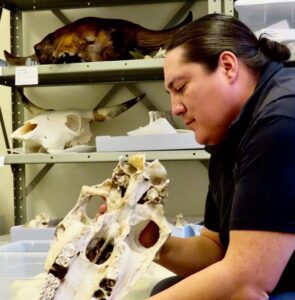“The horse is symbolic of the American West.”
But when and how domesticated horses first reached the region has long been a matter of historical debate.
A new analysis of horse bones gathered from Great Plains museums reveals that horses were in grasslands by the 1600s.

The timing is significant because it matches up with the oral histories of multiple native groups. They claim native people had horses of Spanish descent before European physically arrived in their homelands, perhaps through trading networks.
The study, published in the Science Journal, involved more than 80 co-authors. They include archaeologists and geneticists, as well as historians and scientists from the Lakota, Comanche, and Pawnee nations.
Prior genetic research has shown that the ancestors of horses first evolved in North American millions of years ago. That was before they made their way to the central plains of Europe and Asia, where they were domesticated.
But those early horse ancestors disappeared from the American archaeological record around 6,000 years ago.
In the new study, scientists examined about two dozen sets of horse remains from New Mexico to Idaho to Kansas. They determined the horses were ridden and raised by Great Plains people in the early 1600s.
“Almost every aspect of the human-horse relationship is manifest in the skeleton in some way,” said University of Colorado at Boulder archaeologist William Taylor.
The study found that the horses were present in the American West several decades before the Pueblo Revolt of 1680. That’s when allied native groups pushed Spanish colonizers out of New Mexico.
The retreating armies left behind thousands of horses and livestock. Many historical accounts had inaccurately pinpointed this as the entrance of the horse into the cultures of North America.
“We can disregard the Pueblo Revolt for the spread of the horse into the American West,” said Oxford University archaeologist Peter Mitchell.
But native groups have long disputed this chronology. Oral histories of many groups have told of them encountering horses before they met Europeans.
Multiple oral histories suggest native people first encountered horses that had run away from Spanish camps. Or they had been traded through tribal networks, said Jimmy Arterberry, Comanche tribal member and historian in Medicine Park, Oklahoma.
“We have always known and said that we came across horses before we came across the Spanish,” he said.
Yvette Collin of the Oglala Lakota Nation said the findings show that oral traditions have value to understanding the past.
“Our cultures have been so misrepresented for so long,” she said. “Too often history has been told around us, without us.”
The ambitious research collaboration, initiated by Lakota scholars, should help repair a longstanding mistrust between native groups and archaeologists.
The Native American Graves Protection and Repatriation Act of 1990 established a process for museums to collaborate with tribes in returning stolen sacred objects. It was a key early step in establishing trust and communication, said Carlton Shield, Chief Governor of the Pawnee Nation.
“Hopefully seeing new research will push more native people to develop their own archaeological and anthropological expertise,” he said.
The study also showed that, over time, the genetics of horses in North America switched from being primarily of Spanish origin. It became a mixture of British and Spanish, reflecting the ascent of different empires.
“The shift from a Spanish to a British dominant colonial power can be seen even in the horse,” said geneticist Ludovic Orlando.